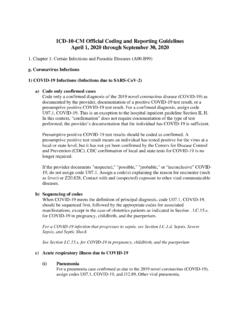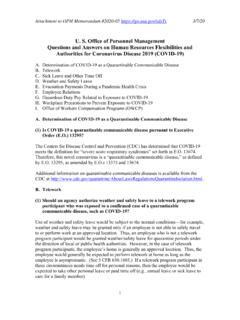Transcription of Guidance for Certifying Deaths Due to Coronavirus Disease ...
1 Department of Health and Human Services Centers for Disease Control and Prevention National Center for Health Statistics National Vital Statistics System Vital Statistics Reporting GuidanceReport No. 3 April 2020 Guidance for Certifying Deaths Due to Coronavirus Disease 2019 (COVID 19)IntroductionIn December 2019 , an outbreak of a respiratory Disease associated with a novel Coronavirus was reported in the city of Wuhan in the Hubei province of the People's Republic of China (1). The virus has spread worldwide and on March 11, 2020, the World Health Organization declared Coronavirus Disease 2019 (COVID 19) a pandemic (2). The first case of COVID 19 in the United States was reported in January 2020 (3) and the first death in February 2020 (4), both in Washington State. Since then, the number of reported cases in the United States has increased and is expected to continue to rise (5).In public health emergencies, mortality surveillance provides crucial information about population-level Disease progression, as well as guides the development of public health interventions and assessment of their impact.
2 Monitoring and analysis of mortality data allow dissemination of critical information to the public and key stakeholders. One of the most important methods of mortality surveillance is through monitoring causes of death as reported on death certificates. Death certificates are registered for every death occurring in the United States, offering a complete picture of mortality nationwide. The death certificate provides essential information about the deceased and the cause(s) and circumstances of death. Appropriate completion of death certificates yields accurate and reliable data for use in epidemiologic analyses and public health reporting. A notable example of the utility of death certificates for public health surveillance is the ongoing monitoring of pneumonia and influenza Deaths . Accurate and timely death certificate data are integral to detecting elevated levels of influenza activity in real time ( ).
3 Monitoring the emergence of COVID 19 in the United States and guiding public health response will also require accurate and timely death reporting. The purpose of this report is to provide Guidance to death certifiers on proper cause-of-death certification for cases where confirmed or suspected COVID 19 infection resulted in death. As clinical Guidance on COVID 19 evolves, this Guidance may be updated, if necessary. When COVID 19 is determined to be a cause of death, it is important that it be reported on the death certificate to assess accurately the effects of this pandemic and appropriately direct public health ReportingWhen reporting cause of death on a death certificate, use any information available, such as medical history, medical records, laboratory tests, an autopsy report, or other sources of relevant information. Similar to many other diagnoses, a cause-of-death statement is an informed medical opinion that should be based on sound medical judgment drawn from clinical training and experience, as well as knowledge of current Disease states and local trends (6).
4 Part IThis section on the death certificate is for reporting the sequence of conditions that led directly to death. The immediate cause of death, which is the Disease or condition that directly preceded death and is not necessarily the underlying cause of death (UCOD), should be reported on line a. The conditions that led to the immediate cause of death should be reported in a logical sequence in terms of time and etiology below it. The UCOD, which is (a) the Disease or injury which initiated the train of morbid events leading directly to death or (b) the circumstances of the accident or violence which produced the fatal injury (7), should be reported on the lowest line used in Part interval: Onset to deathFor each condition reported in Part I, the time interval between the presumed onset of the condition, not the diagnosis, and death should be reported. It is acceptable to approximate the intervals or use general terms, such as hours, days, weeks, or IIOther significant conditions that contributed to the death, but are not a part of the sequence in Part I, should be reported in Part II.
5 Not all conditions present at the time of death have to be reported only those conditions that actually contributed to Statistics Reporting Department of Health and Human Services Centers for Disease Control and Prevention National Center for Health Statistics National Vital Statistics System 2 Certifying Deaths due to COVID 19If COVID 19 played a role in the death, this condition should be specified on the death certificate. In many cases, it is likely that it will be the UCOD, as it can lead to various life-threatening conditions, such as pneumonia and acute respiratory distress syndrome (ARDS). In these cases, COVID 19 should be reported on the lowest line used in Part I with the other conditions to which it gave rise listed on the lines above it. Generally, it is best to avoid abbreviations and acronyms, but COVID 19 is unambiguous, so it is acceptable to report on the death certificate.
6 In some cases, survival from COVID 19 can be complicated by pre-existing chronic conditions, especially those that result in diminished lung capacity, such as chronic obstructive pulmonary Disease (COPD) or asthma. These medical conditions do not cause COVID 19, but can increase the risk of contracting a respiratory infection and death, so these conditions should be reported in Part II and not in Part determining whether COVID 19 played a role in the cause of death, follow the CDC clinical criteria for evaluating a person under investigation for COVID 19 and, where possible, conduct appropriate laboratory testing using Guidance provided by CDC or local health authorities. More information on CDC recommendations for reporting, testing, and specimen collection, including postmortem testing, is available from: and It is important to remember that death certificate reporting may not meet mandatory reporting requirements for reportable diseases; contact the local health department regarding regulations specific to the cases where a definite diagnosis of COVID 19 cannot be made, but it is suspected or likely ( , the circumstances are compelling within a reasonable degree of certainty), it is acceptable to report COVID 19 on a death certificate as probable or presumed.
7 In these instances, certifiers should use their best clinical judgement in determining if a COVID 19 infection was likely. However, please note that testing for COVID 19 should be conducted whenever possible. Common problemsCommon problems in cause-of-death certification include: 1. reporting intermediate causes as the UCOD ( , on the lowest line used in Part I), 2. lack of specificity, and 3. illogical sequences. Intermediate causes are those conditions that typically have multiple possible underlying etiologies and thus, a UCOD must be specified on a line below in Part I. For example, pneumonia is an intermediate cause of death since it can be caused by a variety of infectious agents or by inhaling a liquid or chemical. Pneumonia is important to report in a cause-of-death statement but, generally, it is not the UCOD. The cause of pneumonia, such as COVID 19, needs to be stated on the lowest line used in Part I.
8 Additionally, the reported UCOD should be specific enough to be useful for public health and research purposes. For example, a viral infection can be a UCOD, but it is not specific. A more specific UCOD in this instance could be COVID 19. All causal sequences reported in Part I should be logical in terms of time and pathology. For example, reporting COVID 19 due to chronic obstructive pulmonary Disease in Part I would be an illogical sequence as COPD cannot cause an infection, although it may increase susceptibility to or exacerbate an infection. In this instance, COVID 19 would be reported in Part I as the UCOD and the COPD in Part II. While there can be reasonable differences in medical opinion concerning a sequence that led to a particular death, the causes should always be provided in a logical sequence from the immediate cause on line a. back to the UCOD on the lowest line used in Part of deathThe manner of death, sometimes referred to as circumstances of death, is also reported on death certificates.
9 Natural Deaths are due solely or almost entirely to Disease or the aging process (8). In the case of death due to a COVID 19 infection, the manner of death will almost always be natural. When to Refer to a Medical Examiner or CoronerSome jurisdictions have requirements for referring Deaths involving threats to public health to the medical examiner or coroner, so certifiers should follow the regulations in the jurisdiction in which the death occurred. As always, if a death involved an injury, poisoning, or complications thereof, then the case should be referred. The local medical examiner or coroner should be consulted with questions on referral requirements. ConclusionAn accurate count of the number of Deaths due to COVID 19 infection, which depends in part on proper death certification, is critical to ongoing public health surveillance and response. When a death is due to COVID 19, it is likely the UCOD and thus, it should be reported on the lowest line used in Part I of the death certificate.
10 Ideally, testing for COVID 19 should be Vital Statistics Reporting Department of Health and Human Services Centers for Disease Control and Prevention National Center for Health Statistics National Vital Statistics System 3conducted, but it is acceptable to report COVID 19 on a death certificate without this confirmation if the circumstances are compelling within a reasonable degree of certainty. For more Guidance and training on cause-of-death reporting in general, see the Cause of Death mobile app available from: and the Improving Cause of Death Reporting online training module available from: (free Continuing Medical Education credits and Continuing Nursing Education credits available). For current information on the COVID 19 outbreak, see the CDC website at: Health Organization. Novel Coronavirus , Switzerland. 2020. Available from: Health Organization.













